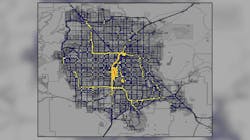Keolis’ new service aims to help transit agencies ‘Evolve’
Keolis North America is releasing Keolis Evolve for use on transit systems in the United States and Canada. The platform provides agencies with intelligence to evaluate and adjust service based on several data points.
In more plain language, Keolis Evolve shows agencies where people are going and how they get there. This is valuable information as agencies strive to serve communities that have undergone a fundamental shift in the way people live and work. Keolis explains this data helps transit agencies make informed decisions to better shape transit services for increased equity and accessibility system wide.
“Keolis Evolve provides detailed area and transit system mobility insights quickly and clearly for transit agencies. At Keolis, we are committed to partnering with public transit agencies to find solutions that will help make transit systems more efficient, more sustainable, more inclusive and responsive to meet the true mobility needs in our communities,” said Keolis North America’s CEO Clement Michel.
Keolis Evolve collects up to 750 million data points of user and non-user trips – depending on the size of the study area – in three-month time periods. Keolis says this information helps agencies and communities navigate the adjusted reality and can aid in the development of a more responsive and agile network.
“COVID-19 has forced all of us in the transit industry to rethink how we support mobility. But we must first truly understand how people are moving today,” said Director of Evolving Mobility for Keolis North America CJ Bright. “Keolis Evolve helps agencies understand their systems by creating better visibility into how passengers travel and how transit services can meet that evolving demand.”
For example, in Greensboro, N.C., Keolis Evolve determined the existing network was designed to move people downtown. However, there was a lot of traffic between the airport and large employment areas. Additionally, an average trip taken on Greensboro Transit Authority (GTA) takes 5.7 times longer than if someone were to drive directly in a car.
With this knowledge, GTA and the city of Greensboro evaluated improved connections to reduce travel time and explored new service options to serve the airport.
Another example involves the Regional Transportation Commission (RTC) of Southern Nevada where Keolis Evolve evaluated not only the mobility needs of the region, but how well RTC of Southern Nevada’s service met those needs. The agency’s market share out of all potential trips in the region was 4.7 percent, yet 47 percent of all weekly trips could have been completed with RTC of Southern Nevada services. Additionally, Keolis Evolve identified four underserved areas that accounted for 15 percent of total mobility need within the region.
Based on the findings, it was recommended that RTC of Southern Nevada tap into ridership potential by changing existing routes, realigning routes to create more one-seat rides and introducing a new fare payment option via chip cards and phones. To better serve areas on the periphery, new routes were recommended to address unmet needs and an on-demand solution was recommended for the four underserved areas.
“Keolis Evolve has helped deliver immediate and relevant insights into our resources and system that used to take over a year to collect,” said Deputy CEO of RTC of Southern Nevada Francis Julien. “The Keolis Evolve data was specific to our Southern Nevada community and our RTC operations, which will help enable us to make actionable decisions to better serve the community with changes to our routes, modes, or resource allocation.”

Mischa Wanek-Libman | Group Editorial Director
Mischa Wanek-Libman is director of communications with Transdev North America. She has more than 20 years of experience working in the transportation industry covering construction projects, engineering challenges, transit and rail operations and best practices.
Wanek-Libman has held top editorial positions at freight rail and public transportation business-to-business publications including as editor-in-chief and editorial director of Mass Transit from 2018-2024. She has been recognized for editorial excellence through her individual work, as well as for collaborative content.
She is an active member of the American Public Transportation Association's Marketing and Communications Committee and served 14 years as a Board Observer on the National Railroad Construction and Maintenance Association (NRC) Board of Directors.
She is a graduate of Drake University in Des Moines, Iowa, where she earned a Bachelor of Arts degree in Journalism and Mass Communication.






